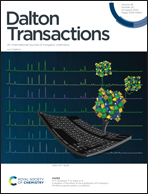Heterobimetallic complexes of IrM (M = FeII, CoII, and NiII) core and bridging 2-(diphenylphosphino)pyridine: electronic structure and electrochemical behavior†
Abstract
Three complexes based on an Ir–M (M = FeII, CoII, and NiII) heterobimetallic core and 2-(diphenylphosphino)pyridine (Ph2PPy) ligand were synthesized via the reaction of trans-[IrCl(CO)(Ph2PPy)2] and the corresponding metal chloride. Their structures were established by single-crystal X-ray diffraction as [Ir(CO)(μ-Cl)(μ-Ph2PPy)2FeCl2]·2CH2Cl2 (2), [IrCl(CO)(μ-Ph2PPy)2CoCl2]·2CH2Cl2 (3), and [Ir(CO)(μ-Cl)(μ-Ph2PPy)2NiCl2]·2CH2Cl2 (4). Time-dependent DFT computations suggest a donor–acceptor interaction between a filled 5dz2 orbital on iridium and an empty orbital on the first-row metal atom, which is supported by UV-vis studies. Magnetic moment measurements show that the first-row metals are in their high-spin electronic configurations. Cyclic voltammetry data show that all the complexes undergo irreversible decomposition upon either reduction or oxidation. Reduction of 4 proceeds through an ECE mechanism. While these complexes are not stable to electrocatalysis conditions, the data presented here refine our understanding of the bonding synergies of the first-row and third-row metals.



 Please wait while we load your content...
Please wait while we load your content...